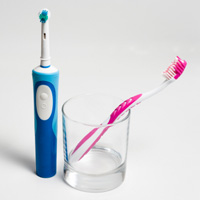E-Cigarettes and Dental Health
Concerned about a brighter smile and better health, many smokers now turn to e-cigarettes as an alternative to conventional cigarettes made of rolled paper and dried tobacco leaves. Many health organizations, however, are concerned about the health and dental implications of these devices.
All about E-Cigarettes
E-cigarettes, short for electronic cigarettes, are battery-powered devices that look like conventional cigarettes. E-cigarettes provide doses of vaporized substances to the user in an aerosol form. The devices contain a heating element that vaporizes a liquid solution.
Depending on the brand of e-cigarettes, the liquid solutions may contain nicotine and flavorings. Nicotine stains teeth. A recent study suggests an association between nicotine and periodontal disease, otherwise known as gum disease. While all conventional cigarettes contain nicotine, some e-cigarettes solutions do not contain this substance.
Many manufacturers offer e-cigarettes that look like conventional rolled cigarettes that contain tobacco. Some produce pen-like e-cigarette devices that look quite different from traditional cigarettes.
Other names for e-cigarettes include electronic vaping devices, personal vaporizers or VPs, and electronic nicotine delivery systems, otherwise known as ENDS.
The Dangers of E-Cigarettes
E-cigarette use is growing dramatically among adolescents, who face special dental health problems. According to a survey by government health regulators, as many as 6.8 percent of all students in grades 6 – 12 have tried e-cigarettes at least one time. The number of middle school kids trying e-cigarettes for the first time increased to 2.7 percent; 20.3 percent of these young, first-time e-cigarette users said they had not yet tried conventional cigarettes. This comes at an age when kids are at greater risk for tooth and gum disease because they are getting braces, go through phases in their diligence to oral hygiene, and are getting the last of their permanent teeth.
The overall effect of e-cigarette use on public health is still unknown. Government agencies note that some researchers are concerned about the effect these devices can have on the developing brains of adolescents, an increased risk for addiction, and the potential for e-cigarettes to become a gateway to conventional tobacco use. Anyone considering switching to e-cigarettes as an alternative to cigarettes should consult with a doctor and a dentist first to discuss the overall health risks. .
Sources:
Malhotra, Ranjan; Kapoor, Anoop; Grover, Vishakha; Kaushal, Sumit. “Nicotine and Periodontal Tissues.” Journal of Indian Society of Periodontology. 2010 Jan-Mar, 14(1): 72-79.
Centers for Disease Control and Prevention. “ Electronic Cigarette Use Among Middle and High School Students – United States, 2011-2012.” September 6, 2013.
Our staff of dental professionals are dedicated to helping you achieve your dental wellness objectives. Thank you for subscribing to our dental wellness newsletter.
In pursuit of a whiter smile and healthier lifestyle, many smokers are switching to e-cigarettes. Major health organizations are concerned about the possible health risks associated with these electronic devices. Researchers are still working to discover whether using e-cigarettes causes medical or dental problems, and if these risks outweigh the benefits of using these devices as replacements for conventional cigarettes. Anyone considering e-cigarettes to prevent damage caused by conventional cigarettes or concerned that e-cigarettes have caused dental problems should consult with their dentist.

